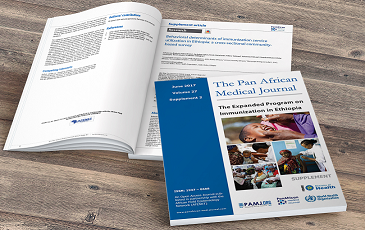Electrocardiography patterns of snake envenomations
Inesse Pouokam, Mazou Ngou Temgoua, Landry Wakheu Tcheunkam, Joel Noutakdie Tochie
Corresponding author: Joel Noutakdie Tochie, Department of Anesthesiology and Intensive Care, Faculty of Medicine and Biomedical Sciences, University of Yaoundé 1, Cameroon 
Received: 09 Jul 2020 - Accepted: 07 Aug 2020 - Published: 17 Aug 2020
Domain: Public health,Neglected diseases
Keywords: Electrophysiology, patterns, snake, heart, envenomation
©Inesse Pouokam et al. PAMJ - One Health (ISSN: 2707-2800). This is an Open Access article distributed under the terms of the Creative Commons Attribution International 4.0 License (https://creativecommons.org/licenses/by/4.0/), which permits unrestricted use, distribution, and reproduction in any medium, provided the original work is properly cited.
Cite this article: Inesse Pouokam et al. Electrocardiography patterns of snake envenomations. PAMJ - One Health. 2020;2:23. [doi: 10.11604/pamj-oh.2020.2.23.24917]
Available online at: https://www.one-health.panafrican-med-journal.com/content/article/2/23/full
Electrocardiography patterns of snake envenomations
Inesse Pouokam1,2, Mazou Ngou Temgoua3, Landry Wakheu Tcheunkam4, Joel Noutakdie Tochie5,6,&
&Corresponding author
Snakebite envenomation constitutes a neglected tropical disease of public health importance. This is evident by over five million persons per year especially young farmers being bitten by snakes in rural areas. Hence, equally making snakebites an occupational disease. Snake envenomation leads to several toxic syndromes including cardiac toxicity. The latter may lead to severe cardiac electrical conductivity disorders with resultant potentially life-threatening cardiac arrhythmias, myocardial infarctions, heart failure and even of cardiac arrest which have been less described. This article aims to describe the electrocardiography dysfunctions caused by snake envenomation to improve the management of snake envenomed patients through early detection, treatment and management of these snake envenomation electrocardiography-related complications.
Snake envenomation and public health implications: recognized by WHO as a Neglected Tropical Disease in 2017, Snakebite and its envenomation constitute a major public health concern worldwide [1]. Globally, each year, 4.5-5.4 million people are victims of snakebites, 1.8-2.7 million cases of snake envenomations occur and, 81,000-138,000 patients have a fatal outcome [2,3]. Snakebite disproportionately affects rural regions like sub-Saharan Africa (SSA), Asia and Latin America [4]. In SSA, 95% of snakebites and 97% of snakebite-related deaths occur [5] among young male farmers in rural areas during agricultural activity [6], hence, also making snakebite an occupational hazard [7]. Snakebite incidence is reported at over five million cases per year in SSA in general [5], and at 200 snakebites per 100,000 persons [7] and 665 per 100, 000 inhabitants [8] in some regions SSA countries. Survivals of snake envenomation may sustain lifelong physical disabilities such as blindness, extensive scarring and contractures, restricted limb mobility, limb amputation due to venom-induced limb necrosis or gangrene [10,11]. The public health challenges associated with snakebites in SSA are further compounded by suboptimal disease surveillance, poor health-seeking behaviours of snake-bitten victims with 50-90% patients having a preference for alternative and complementary medicine as first-line treatment option leading to delayed hospital presentation of snaked envenomed patients; under-production of antivenom serum (AVS) within SSA; scarcity of AVS ; the relatively high cost of AVS; unscrupulous marketing of inappropriate imported AVS especially from India and financial constraints of patients [7,12,13]. In an observational study that mapped venomous snakes with healthcare access of high-risk populations and availability of effective AVS, it was found that several areas of SSA are vulnerable to snakebites [10]. There are 93 million people in the highest risk areas. In an effort to draw attention to the problems posed by venomous snakebites worldwide and to spur strategies that improved snake envenomed patients´ outcomes, the World Health Organization designated snakebite as a neglected tropical disease [1].
Snake envenomation and its syndromes: snake envenoming is defined as a potentially life-threatening disease resulting from the injection of venom, a complex mixture of different toxins, following the bite of a venomous snake. Snake venoms are a complex mixture of toxic low molecular weight polypeptypes, glycoproteins, metal ions and proteolytic enzymes such as metalloproteinases and hemorrhagins [14]. There are several snake species worldwide. The most frequent snake genera encountered worldwide are Elapidae (e.g. Naja naja, Naja melanoleuca, Dendroaspis polylepis, Bungarus caeruleus, Oxyuranus scutellatus) and Viperidae (e.g. Echis ocellatus, Echis carinatus, Bitis arietans, Atractaspis engaddensis, Daboia russelii, Bothrops atrox, Bothrops asper). Snakebites are responsible for various envenomation syndromes such as; neurotoxic syndrome: muscular weakness, paresthesis, spreading paralysis, dysphagia, dysphasia, ptosis, mydriasis or myosis, external ophthalmoplegia, dyspnea, respiratory arrest, fasciculation, hypersalivation, agitation, somnolence and convulsions; cardiotoxic syndrome: bradycardia or tachycardia, cardiac arrhythmia, hypertension, hypotension, hypovolemic shock, QTc prolongation, ST-segment changes, T-wave inversion, tall T-waves, atrioventricular block (AVB), Takotsubo/Stress/Broken cardiomyopathy (chest pain, shortness of breath, palpitations, marked apical left ventricular akinesis), troponin elevation; myotoxic syndrome: muscular pain, stiffness rhabdomyolysis, myoglobinuria; elevated creatine kinase: CK-MM; haematotoxic or vasculotoxic syndrome: ecchymoses, petechial haemorrhage, epistaxis, haematemesis, melaena, haematuria; venom-induced consumpsion, coagulopathy (elevated international normalized ratio, raised activated partial thromboplastin time, increased in fibrinogen levels, thrombopaenia), disseminated intravascular coagulation; systemic syndrome: vomiting, nausea, hyperthermia, hypothermia; cytotoxic syndrome: pain, oedema, swelling, skin redness; gastrointestinal syndrome: diarrhea, abdominal distension. Neurotoxic and cardiotoxic syndromes are often caused by Elapidae, while haematotoxic syndrome is a main feature of envenomation by vipers [9,15]. Meanwhile systemic, cytotoxic and gastrointestinal syndromes can be seen in both envenomations due to Elapidae and Viperidae [16]. In a recent epidemiological survey carried out in Cameroon, the most common snake envenomation syndromes were cytotoxic syndromes (56%), systemic syndrome (33.3%), digestive syndromes (30%) and neurotoxic syndrome (3%) [8]. Through their cardiac toxic effects, the venoms of snakes can cause both dysfunctions in cardiac myocardial function and the electrically cardiac conductivity leading to myocarditis, cardiogenic shock, myocardial infarction, conduction disorders and cardiac arrest [11,17-22]. The cardiac toxicity may be due to the direct effects of the components of snake venoms on the heart or may be indirectly caused by hyperkalemia from rhadomyolysis, acute kidney injury, hypoxic respiratory failure, metabolic disturbances, myotoxic phospholipases A2 (PLA2) secondary to snake envenoming as well as severe anaphylactic reactions caused by the snake venom and/or AVS [11,17-22].
Snake envenomation and cardiovascular complications
Clinical aspects: cardiac toxicity is a well-documented complication of envenomation [12,19-24] which can be caused by both cobra and viper snake species [12,19,23,25-27]. It occurred more frequently in individuals with underlying co-morbidities (diabetes, hypertension, ischemic heart disease, advanced age, hyperlipidemia) [25,28]. Patients with cardiac involvement may be asymptomatic or develop non-specific manifestations. Common cardiovascular clinical manifestations of snake envenomation are mainly: palpitation, tachycardia, dizziness, chest pain, hypotension, irregularly irregular rhythm, primary or secondary anaphylaxis (e.g. Viper berus or Daboia palaestinae), shock [12,19,25-27]. Some review revealed that myocardial infarction following snake envenomation is mostly reported in young adult males from tropical regions with no history of coronary artery risk factors [19].
Electrocardiography (ECG) dysfunction due to snake envenomation: the venom directly or indirectly causes functional changes in heart tissue physiology as well as cardiac cell death [19-24]. The various toxins in the venom target ionic channels in excitable membranes of cardiac cells or cardiac cell membranes, thereby, altering their action potentials (e.g. depolarization, repolarization, alterations in its duration) or significant changes in intracellular ions activity. These changes may lead to reversible or even irreversible life-threatening cardiac arrhythmias and eventually heart failure [20]. Myocardial infarction (MI) is a common cardiovascular finding in patients with snake envenomation caused by impaired coronary perfusion secondary to anaphylactic shock, venom vasodilators, iatrogenic causes (ACE inhibitors, Beta-Blockers, kininogens), hypercatecholamine Takotsubo cardiomyopathy or sarafatoxin effects following Atractaspis envenoming. Multiple case reports of myocardial infarction following snake bites have been reported [17,22]. In a scoping review by Kariyanna et al, 65% ST-segment elevation and 10% ST-segment depression were reported as main ECG findings of MI [17]. Other ECG findings were T-wave inversion in 5%, T-wave flattening in 5% and QT prolongation in 5% [17]. Among patients with cardiac arrest following snake envenomation, 14% were due to ventricular fibrillation and 5% asystole [17]. Major Electrocardiography findings following snake envenomation could be classed into rhythm and conduction disorders.
Rhythm disorders: there are many reports describing arrhythmia induced by cobras´ envenomations [16,21]. Some rhythmic disorders include Bitis arietans bradycardia or Echis arrhythmias. ECG in patients with envenomation show nonspecific changes such as sinus arrest with junctional escape rhythm and retrograde P-waves with a heart rate of 40beats/min, suggestive of sinus node dysfunction, however, on the 3rd day of hospitalization for snake envenomation, a repeat ECG showed normal sinus rhythm [26]. Sinus tachycardia and sinus bradycardia have also been reported after snake envenomation [22]. T-wave inversion and sinus bradycardia are also ECG changes seen in cases of envenomation [28]. Atrial fibrillation is also a common conduction disorder seen in snake envenomation with a fast ventricular rate of 126 beats/minute which resolved 24 hours after injection of AVS [12]. However, ECG taken three hours post envenomation in some patients who do not present any cardiovascular symptoms at admission revealed new-onset atrial fibrillation (AF) which was managed successfully with amiodarone [12]. It suggests that in practice, patients may need prolonged cardiac monitoring even when the acute phase is over. Pre-existing first-degree atrioventricular block (AVB) is an independent risk factor for the development of AF in some snake envenomed patients [27].
Conduction disorders: conductions disorders following snake envenomation have rarely been described in the literature. Intermittent 2:1 Second-degree heart block was seen in some cases of viper bite [27]. A de novo first-degree AVB has also been seen in cases of snake envenomation [28]. Also, cases of bundle branch bloc, and complete heart block have been described [20].
Management of cardiac electrophysiological dysfunction due to snake envenomation
General principles at the scene of the snakebite incident: first aids measures aimed at reducing the spread of the snake venom are indicated such as immobilizing the bitten area on the body; ancillary treatment consisting of administering analgesics; wound disinfection; snake species taxonomic identification for specific AVS immunotherapy; rapid transfer of the patient to the hospital [29].
Hospital management: respiratory support by mechanical ventilation for patients with respiratory failure (neurotoxicity) [29]. Anticholinesterases using neostigmine, administer after atropine or glycopyrrolate to prevent excessive cholinergic effects [29]. Specific management of cardiac electrophysiological dysfunctions due to snake envenomation include AVS to neutralize the snake venom and reduce cardiac electrophysiological dysfunctions, intravenous lidocaine and amiodarone against cardiac arrhythmias and beta-blockers against AVB, AF, and ventricular fibrillation [30].
Electrocardiography changes are common in patients who present with snake envenomation. Screening of cardiac arrhythmia or conduction disorders in these patients particularly in those with severe envenomation could prevent death by early detection, management and adequate follow-up.
The authors declare no competing interests.
All the authors have read and agreed to the final manuscript.
- WHO. Snakebite envenomation turns again into a neglected tropical disease. Accessed on 07 Jul 2020.
- WHO. Snakebite envenoming. Accessed on 07 Jul 2020.
- Chippaux JP. Snake-bites: appraisal of the global situation. Bull World Health Organ. 1998;76(5):515-24. PubMed | Google Scholar
- Kasturiratne A, Wickremasinghe AR, de Silva N, Gunawardena NK, Pathmeswaran A, Premaratna R et al. The global burden of snakebite: a literature analysis and modelling based on regional estimates of envenoming and deaths. PLoS Med. 2008;5(11):e218. PubMed | Google Scholar
- Chippaux JP. Estimate of the burden of snakebites in sub-Saharan Africa: a meta-analytic approach. Toxicon. 2011;57(4):586-99. PubMed | Google Scholar
- Chippaux JP, Rage-Andrieux V, Le Mener-Delore V, Charrondière M, Sagot P, Lang J. Epidémiologie des envenimations ophidiennes dans le nord du Cameroun. Bull Soc Pathol Exot. 2002;95(3):184-7. Google Scholar
- Tochie JN, Temgoua MN, Njim T, Celestin D, Tankeu R, Nkemngu NJ. The neglected burden of snakebites in Cameroon: a review of the epidemiology, management and public health challenges. BMC Research Notes. 2017;10(1):405. PubMed | Google Scholar
- Alcoba G, Chabloz M, Eyong J, Wanda F, Ochoa C, Comte E et al. Snakebite epidemiology and health-seeking behavior in Akonolinga health district, Cameroon: Crosssectional study. PLoS Negl Trop Dis. 2020;14(6): e0008334. PubMed | Google Scholar
- Gutiérrez JM, Theakston RD, Warrell DA. Confronting the neglected problem of snake bite envenoming: the need for a global partnership. PLoS Med. 2006;3(6):e150. PubMed | Google Scholar
- WHO. Rabies and envenomings: a neglected public health issue: report of a consultative meeting. Geneva: WHO, Library Cataloguing-in-Publication Data. 2007.
- Virmani S, Bhat R, Rao R, Kapur R, Dsouza S. Paroxysmal Atrial Fibrillation due to Venomous Snake Bite. J Clin Diagn Res. 2017;11(6):OD01-2. PubMed | Google Scholar
- Tianyi1 F-L, Agbor VN, Tochie JN, Kadia BM, Nkwescheu AS. Community-based audits of snake envenomations in a resource-challenged setting of Cameroon: case series. BMC Res Notes. 2018 May 18;11(1):317. PubMed | Google Scholar
- Tochie JN, Tianyi FL, Tchouakam DN, Nkwescheu AS. Primary prevention of snakebite envenoming in resource-limited settings. Environ Dis. 2019; 4:33-4. Google Scholar
- Gras S, Plantefève G, Baud F, Chippaux JP. Snakebite on the hand: lessons from two clinical cases illustrating difficulties of surgical indication. J Venom Anim Toxins Trop Dis. 2012;18(4):467-77. Google Scholar
- WHO/Regional Office for South-East Asia. Guidelines for the Management of snake-bites, first edition. WHO. March 2010.
- Keng Sheng Chew H, Wei Khor R, Ahmad N, Hisamuddin NAR. A five-year retrospective review of snakebite patients admitted to a tertiary university hospital in Malaysia. Int J Emerg Med. 2011 Jul 13;4:41. PubMed | Google Scholar
- Kariyanna PT, Jayarangaiah A, Kamran H, Schechter J, Soroka S, Amarnani A et al. Myocardial infarction after snakebite envenomation: a scoping review. SciFed journal of cardiology. 2018;2(3):21. PubMed | Google Scholar
- Frangež R, Grandic M, Vrecl M. Cardiovascular Pathophysiology Produced by Natural Toxins and Their Possible Therapeutic Implications. Cardiotoxicity of Oncologic Treatments. Google Scholar
- Gupta P, Mahajan N, Gupta R, Gupta P, Chawdhary I, Singh P et al. Cardiotoxicity profile of snake bite. JK Science. 2013;15(4):169-173. Google Scholar
- Nayak KC, Jain AK, Sharda DP, Mishra SN. Profile of cardiac complications of snake bite. Indian Heart Journal. 1990;42(3);185-188. PubMed | Google Scholar
- Sudulagunta SR, Sodalagunta MB, Khorram H, Kumar SBR. Cardiotoxicity and respiratory failure due to Cobra bite. Scholar Journal of Applied Medical Sciences. 2015;3(5A):1830-1833. Google Scholar
- Gomes RAF, Cantarelli FL, Vieira FA, Macedo Jr ARA, Gouveia MMdA, Feitosa ADdM. Myocardial infarction after snake bite. International Journal of Cardiovascular Sciences. 2018;31(1):79-81. Google Scholar
- Kim OH, Lee JW, Kim HI, Cha K, Kim H, Lee KH et al. Adverse Cardiovascular Events after a Venomous Snakebite in Korea. Yonsei Med J. 2016;57(2):512-7. PubMed | Google Scholar
- Agarwal A, Kumar T, Ravindranath KS, Bhat P, Manjunath CN, Agarwal N. Sinus node dysfunction complicating viper bite. Asian Cardiovasc Thorac Ann. 2015;23(2):212-4. PubMed | Google Scholar
- Moore RS. Second-degree heart block associated with envenomation by Vipera berus. Emergency Medicine Journal. 1988;5(2):116-8. PubMed | Google Scholar
- John Binu A, Kumar Mishra A, Gunasekaran K, Iyadurai R. Cardiovascular manifestations and patient outcomes following snake envenomation: a pilot study. Trop Doct. 2019;49(1):10-3. PubMed | Google Scholar
- Uhm JS, Shim J, Wi J, Mun HS, Park J, Park SH et al. First-degree atrioventricular block is associated with advanced atrioventricular block, atrial fibrillation and left ventricular dysfunction in patients with hypertension. J Hypertens. 2014;32(5):1115-20. PubMed | Google Scholar
- Dan Q, Kenneth Z. Reversible Atrial Fibrillation Following Crotalinae Envenomation. The journal of venomous animals and toxins including tropical diseases. 2017; 23:16. PubMed | Google Scholar
- Seifert SA. Evaluation and management of coral snakebites. Uptodate 2020.
- White J. Snakebites worldwide: Management. Uptodate 2020. Accessed on 10 July 2020.











